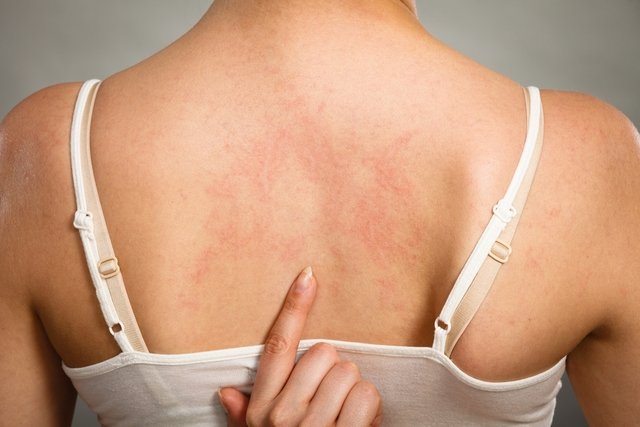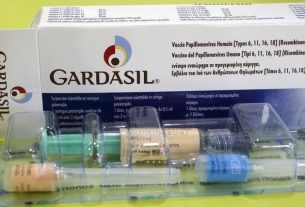Cholinergic urticaria is a type of hives that appears when body temperature increases, causing symptoms such as itching and/or stinging sensations on the skin, red spots on the trunk and swelling in parts of the body.
Cholinergic urticaria, also known as heat allergy, can be triggered by situations that cause changes in the skin, such as sweat allergy and an abnormal reaction to the stimulus caused by heat, which lead to irritation.
If cholinergic urticaria is suspected, it is recommended to consult a dermatologist. Although there is no cure, treatment is usually carried out with anti-allergy medications according to the doctor’s instructions to alleviate symptoms.

Main symptoms
The main symptoms of cholinergic urticaria are:
- Itching and/or stinging sensation on the skin;
- Small lumps, plaques and/or reddish spots on the body;
- Swelling in parts of the body such as lips, eyes or throat, also known as angioedema;
- Cough or shortness of breath;
- Stomach pain, nausea or diarrhea;
- Low pressure.
Typically, the symptoms of cholinergic urticaria are caused by an increase in body temperature due to physical exercise, hot baths and, in some people, stress, consumption of hot drinks or spicy foods, for example.
Skin lesions are most common on the trunk, rarely affect the palms of the hands, soles of the feet and armpits and tend to improve quickly within 15 minutes to 1 hour.
In more serious cases, cholinergic urticaria can cause symptoms such as body swelling, low blood pressure or shortness of breath, indicating angioedema or anaphylaxis, which are more serious allergic reactions.
How to confirm the diagnosis
The diagnosis of cholinergic urticaria is made by the dermatologist taking into account the characteristics of the skin lesions and their reaction to the increase in body temperature.
The dermatologist can also perform the provocation test to confirm the diagnosis, which consists of stimulating an increase in body temperature, through physical exercise or a hot bath, for example, to check the development of lesions.
Heat rash is a type of skin reaction to heat that can sometimes be confused with cholinergic urticaria, but which happens when sweat clogs and inflames the pores, causing lumps and itchy skin. See how to identify and treat heat rash.
Make an appointment with your nearest dermatologist to evaluate your symptoms:
Taking care of your health has never been easier!
Possible causes
Cholinergic urticaria is believed to be caused by changes in the skin such as blocked pores, sensitivity to inflammatory substances present in sweat and an abnormal reaction to the release of the neurotransmitter acetylcholine when the body temperature rises.
How the treatment is carried out
Although there is no cure, cholinergic urticaria is usually treated with anti-allergy medications, such as hydroxyzine and cetirizine, to alleviate symptoms and should be used in accordance with the dermatologist’s instructions.
The doctor may also recommend the use of corticosteroid medications directly into the vein, immunobiologicals, such as omalizumab, and desensitization therapy, which consists of exposing the person to their own sweat to stimulate the body’s adaptation and alleviate the allergy.
Additionally, for some people, taking steps to reduce stress, such as relaxing and getting enough sleep, and avoiding alcohol or hot drinks and spicy foods, for example, can help control hives.
Home treatment for cholinergic urticaria
Natural treatment for cholinergic urticaria can be carried out to complement the treatment indicated by the doctor, with some options being cold compresses made from chamomile, pansy plants or flaxseed porridge, as they have anti-inflammatory properties, for example. Check out more options for home remedies for skin allergies.
Bibliography
- FUKUNAGA, Atsushi et al. Cholinergic Urticaria: Subtype Classification and Clinical Approach. Am J Clin Dermatol. Vol.24, n.1. 41-54, 2023
- FUKUNAGA, Atsushi et al. Cholinergic urticaria: epidemiology, physiopathology, new categorization, and management. Clin Auton Res. Vol.28, n.1. 103-113, 2018
- ABAJAN, Marina et al. Physical urticarias and cholinergic urticaria. Immunol Allergy Clin North Am. Vol.34, n.1. 73-88, 2014
- BRAZILIAN SOCIETY OF DERMATOLOGY. Urticaria. Available at: <https://www.sbd.org.br/dermatologia/pele/doencas-e-problemas/urticaria/73/>. Accessed on February 25, 2020

Sign up for our newsletter and stay up to date with exclusive news
that can transform your routine!
Warning: Undefined array key "title" in /home/storelat/public_html/wp-content/plugins/link-whisper-premium/templates/frontend/related-posts.php on line 12
Warning: Undefined array key "title_tag" in /home/storelat/public_html/wp-content/plugins/link-whisper-premium/templates/frontend/related-posts.php on line 13




